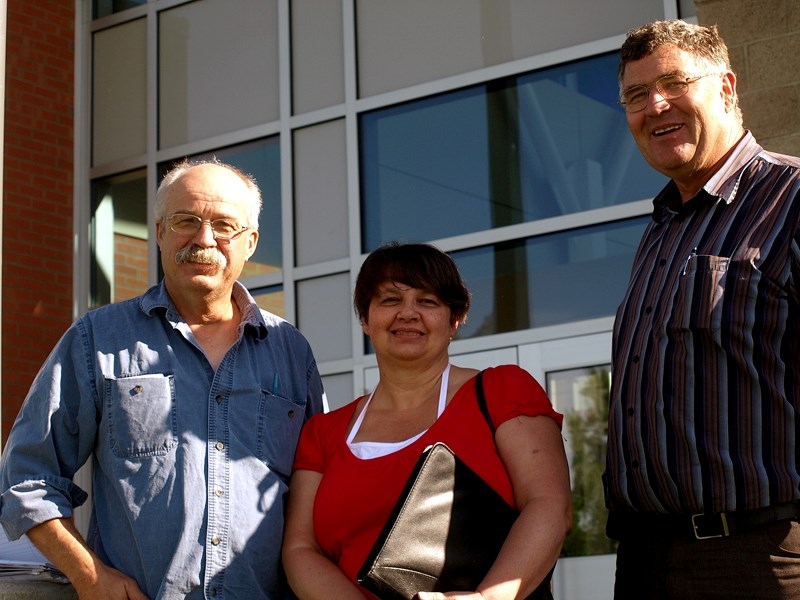Emotions came perilously close to the breaking point at an Alberta Municipal Government Board (MGB) hearing last week as warring sides into the controversial Elsner subdivision development case steadfastly stood their grounds on the contentious stormwater drainage issue.Sundre-area landowner Paddy Munro, who lives near the proposed rural residential development southeast of town and is vehemently opposed to its construction, squared off against lawyer David Smitten.The lawyer, who represents Jack and Cindy Elsner, challenged Munro, who is the reeve of Mountain View County, on whether he had made any moves to scrap the original bylaw containing the concept plan for the development, which has been dragging through a quagmire of controversy and bureaucratic hurdles for the past two years.Munro was forced to admit to Smitten that council has not rescinded the bylaw.Smitten then asked Munro whether he as reeve had directed an engineering study into the quarter section of land, which is being envisioned to have 12 one-acre residential lots, and facing serious questions over stormwater drainage.Munro would only say, ìWe are in the process.îThe lawyer continued to grill the county reeve on this point until Munro shot back, ìAre you deaf?îSmitten persisted but Munro kept his ground. ìI don't think you are listening.îFollowing a brief intervention from the three-member board panel Munro conceded the process had ìstarted.îìWe've engaged the planning department to do further stormwater engineering studies,î said Munro outside the hearing. He added during his testimony and again outside the hearing room that the stormwater drainage issue, which is at the heart of the Elsner case, could ultimately have a devastating impact for residents in and around Sundre.ìThe county is potentially at risk for millions of dollars in damages if there is more of these developments. They are causing us nothing but nightmares,î said Munro, adding that officials in the Town of Sundre have also expressed their concern to him. ìWe know the impact of high-density areas. We know what happens when trees are taken down for development.ìThat (Elsner proposal) is higher density than the land can sustain.îLast week's hearing at Olds College follows the county's Municipal Planning Commission's (MPC) decision on April 21 to deny the Elsners' subdivision application. MPC refused the application, despite a recommendation of approval from the county's planning department, due to stormwater and drainage concerns. MPC felt the Elsner proposal did not comply with the direction of the 2000 Komex report.As well, MPC said inadequate emergency access, along with a 10-metre width of the road into the property, was not suitable for the proposed traffic at the site.The county's planning department did recognize the drainage issue but recommended conditions to address it in its report to MPC.The Elsners appealed the MPC decision to the MGB, a move unsuccessfully contested by the county on grounds its own subdivision and development appeal board was the proper body.During the MGB hearing the panel first heard overviews of the case from both sides. It then heard testimony from three landowners, including Munro, who either own property adjacent or near the Elsner land.Landowner Robin Graham, who lives immediately southwest of the Elsner property, told the panel he had serious concerns over the lack of emergency access into the site, adding that a current county road buttressing the property is inadequate and is directly over a high-pressure butane pipeline.ìThere is no way for people to get out and emergency vehicles to get in,î said Graham.Arlene Nerrie, an adjacent landowner to the west of the Elsner property, said the water table in the area is already so high she can't construct a basement to her home.She said the Elsners have already removed a ìsignificantî amount of trees from their property, which she claimed has resulted in greater drainage runoff directly on her land. She said the problems would become worse if the Elsner development is allowed to proceed.ìThere will be more building of lots, paved roads ñ more impact,î said Nerrie. ìUnless there is going to be a diversion that stormwater is going to be significant.îThe Elsners did not offer testimony during the hearing and they declined to comment after. However, Tom Gilliss, project manager for MPE Engineering Ltd., was called on behalf of the Elsners and he told the panel that groundwater concerns could be addressed in ways that would not have a significant impact on adjacent landowners.ìThe stormwater pond can be repositioned and the lots can be graded,î said Gilliss, adding that a detailed design for a mitigating system against excessive stormwater and drainage can be produced to satisfy concerns raised by both MPC and the county. ìThere are a half dozen things that can be done to mitigate this.îDuring his final summation, Smitten said everything his clients prepared over the past two years complied with both the area structure plan and the land-use bylaw. He reiterated the Elsners completed all studies that were both required and asked for by the county, including those for wildlife, engineering and stormwater and drainage.ìThey have gone far and above the land bylaw requirements,î said Smitten, adding his clients' due diligence also complied with the guidelines set by the Komex report.The lawyer told the panel the Elsners were not given a chance by MPC to address its concerns, which he added could be dealt with by additional detailed plans to confront the stormwater and drainage issues.He asked the board to approve the development with conditions, and that due to the ongoing animosity between sides, a third-party planner should be appointed to move the process along.The hearing on Aug. 25, originally scheduled for two days, was completed. The panel will now await additional written information to be submitted. It has the option of reconvening to hear further testimony. When all evidence is delivered the panel will then issue a written decision, a process that could take six to eight weeks.




